My Friday Post is a day late (very busy week here), no doubt completely discombobulating your weekly schedule again. Sorry.
Pentecost
On Pentecost the Holy Spirit came with power, and the revelation of God the Holy Trinity was completed.
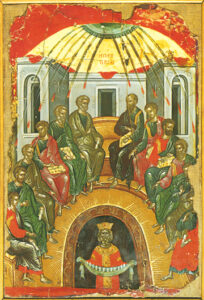
Stavronikita Monastery, Mount Athos, 16th c
Most icons courtesy of Saint Isaac’s Skete, skete.com
Now, imagine someone understood no Christian teachings, and came to me and said: “Please explain this Holy Trinity to me.”
I can think of two approaches I might take:
1 I could try to describe and explain the Holy Trinity. (This is what I would have done many years ago.)
or
2 I could say “NO!” (This is the approach I’d take now. I’ll explain this later.)
_______________________________
1 A Description of God the Holy Trinity for a Neophyte
Me: “We believe there is one God. However, within that one God, there are three distinct Persons, not to be confused with one another: the Father, the Son and the Holy Spirit who comprise the Holy Trinity. All of them are eternal, equal in every way and fully united in all things. However, there are not three Gods. There is only one God. All three Persons of the Holy Trinity are to be ‘worshiped and glorified’ as one God.”
Neophyte: “But… but…but… that makes no sense.”
Me: “I agree. It makes no logical sense. Let me continue:
“God the Father is Creator of Heaven and earth. Therefore He dwells beyond our time and space, so that no human words are adequate to describe Him – “in inaccessible light, whom no man has seen or ever can see”. However, Jesus Christ the Son of God said “To see Me is to see the Father”. He described the “character” of the Father, which His Apostle John summed up like this: “God is light and in Him is no darkness at all”.
Neophyte: “But, then why is there so much darkness in the world God created?”
Me: ” We have no good explanation for that.”
“God is called “He”, though in fact He is beyond sexual categories, whether male or female. However, both men and women are created equally in His image.”
Neophyte: “I don’t understand that.”
Me: “Neither do we.”

“The Father is the source of all things including the Son and the Spirit, and He takes ‘precedence’ over them in a way we do not really understand.
“Jesus Christ is also the ‘one Lord… through whom all things were made”, called the Son not because He is younger than the Father, but rather because He is of the same ‘essence’ as the Father – just as a human son is human like his father. The Son is not created but rather ‘begotten’ of the Father. We do not understand what the word ‘begotten’ means here. Without leaving Heaven, the Son of God came to earth and took flesh of the Virgin Mary, so that He was fully human, yet also fully God. He was crucified and raised from the dead and thereby conquered death for Himself and for all mankind – even though we all still die. He ascended bodily into Heaven, but He is also still here on earth. He remains eternally both God and Man.”
Neophyte: “There’s an awful lot you don’t understand here.”
Me: “Yes, there is.”
“Like the Father and the Son, the Holy Spirit also is ‘the Lord’, ‘the Creator of life’ and is addressed as ‘He’, not as ‘it’. The Spirit ‘proceeds’ from the Father, but is also ‘sent’ by the Son. We do not understand what the word ‘proceed” means here, nor exactly in what way He is ‘sent’. The know the Holy Spirit is present ‘at all times and in all places’, although He cannot be heard, seen or touched”.
“Now, do you have any questions?”
Neophyte: “Thanks. ‘Bye. Maybe I’ll see you sometime.”
______________________________________
Therefore, as promised, here is the more simple answer I would now give to a neophyte who asked me to describe the Holy Trinity:
“No”.
2 No. Because you cannot even begin to grasp the dogmas and doctrines of the Faith, unless first you immerse yourself in the life of the Church: Worship, Pray. Become part of the Community. Learn to Fast. Give to the Church and to the needy. Learn to forgive. Live the Christian Way for quite a while.
This is because Orthodoxy is not grounded in logic, philosophy, theology, doctrines, systematic explanations. Orthodoxy is based on Life, living the Christian Way, and above all the Church’s experience with God. Then in that context, we try as best we can to find words, very inadequate words, to describe what God has shown us of Himself.
Note the wording of the Creed. We “believe in one God”, not “We believe there is one God”. The doctrine of the Trinity is not a logical philosophical construction. We “believe in”, “put our trust in” the Mystery of the Holy Trinity, just as I might say “I believe in my wife”. Do I understand her? Well, a little, but overall no more than she understands me! In many ways, after 55 years of marriage (55 years yesterday!), we are even more mysterious to each other. * But I absolutely “believe in” Dianna. I trust her completely, because of my experience with her, because I have known her all these years. Out of that experience I could now write a “creed” about her, trying very inadequatedly to describe the mystery. But those words wouldn’t even begin to do her justice. And if you didn’t know her well personally, the creed would be chiefly empty words to you. (Sorry, dear, for using you as an example again.)
- Human beings are like God: The better we know them, the greater the mystery becomes. Not surprising, since we are created in the image of God.
This is why, in early Church times, before people were even allowed to say the Creed, first they had to become catechumens (“learners”). The Catechumenate lasted often as long as three years. During that time catechumens were carefully instructed and immersed in Church life, in the Christian Way.
Late in the Catechumenate, catechumens were taught the Creed. They were permitted to say the Creed for the first time just before they were Baptized. Then afterwards, also for the first time, they attended the “sacramental” Eucharistic part of Divine Liturgy beginning with the Great Entrance, and received Holy Communion.
 courtesy of johnsanidopoulos.com
courtesy of johnsanidopoulos.com
We can read this instruction in the famous 23 Catechetical Lectures * of Saint Cyril, Bishop of Jerusalem (Fourth Century). However, Saint Cyril did not teach the catechumens about Holy Baptism and the Holy Eucharist till after they had been baptized and received their first Communions, because (to paraphrase him) we must first experience the Mysteries of the Church before we can even begin to understand them.
- These are well worth reading. They’re short, in simple language, and show clearly how the Faith and Practice of the Church are almost unchanged over these seventeen centuries. Go to: https://www.newadvent.org/fathers/3101.htm
So… if someone has been living the Orthodox Way for a considerable period of time, either as a full member or as a catechumen, and asked me to explain the doctrine of the Trinity, here is the approach I would now take:
How the Church Fathers “deduced” the doctrine of the Holy Trinity
Certainly this was not invented by the Fathers as a simple way of teaching the Faith!
I cannot imagine a more perplexing and convoluted doctrine for purposes of evangelism than the doctrine of the Trinity. Muslims have it easy: “There is no god but God [no allah but Allah] and Muhammad is his messenger.” – easy to proclaim, easy to understand. Judaism has the same advantage, though they seem to have little missionary zeal for sharing it.
But One God in Three Persons? Christianity did not take over the world by first teaching that doctrine.
The doctrine of the Trinity was developed as the result of God’s revelation of Himself to us, from our experience with God culminating in Jesus Christ. That revelation was passed on to us in the Tradition of the Church, recorded first in the Holy Scriptures, then clarified by the Church Fathers.
We scarcely have time to dig into this here, but I’ll try to sum things up as best and as briefly as I can.
One God
This was revealed by God Himself to a small group of Middle Eastern people, the Jews, recorded in what Christians now call the Old Testament. God at first showed Himself to be the God they should worship and obey. He then progressively showed Himself to be the One God, the only Creator of all that exists. This revelation was made to no other people. By about the time of the birth of Christ, some Greek philosophers were finally concluding that there must be one supreme god within the universe. Meanwhile the Jews had long known the One God who had created the universe.
1 God the Father.
That God is our Father was first revealed to us by Jesus Christ, His Son. At age 30 Christ began His public ministry, calling Himself the Son of God, calling God His Father, praying to the Father as to a distinct Person. He also taught us to pray “Our Father”. This was something new: God is referred to as “father” only 13 times in the Old Testament, but is called “Father” 180 times in the (much shorter) New Testament. Christ taught that God the Father cares for each of us: “even the hairs of your head have been numbered”! He taught that the Father is all-good. As mentioned above, the Apostle John wrote later: “This is the message we have heard from Him and declare to you: God is light; in Him there is no darkness at all.” and “God is love”. With all the evil in the world, why should we believe those words? Because we believe Jesus Christ is God in the flesh, and just before His death, Jesus said “Whoever has seen Me has seen the Father”, and “Greater love has no man than that he die for his friends”. Then He voluntarily gave Himself over to death for us and rose from death. We have seen God’s love and power over evil. We believe God is all Light, all Good, because of His Son Jesus Christ.
2 God the Son.
Twenty centuries ago there lived a young Jewish Man unlike any other man who has ever lived, born (as came to be known later) without aid of a man to the young Jewish Virgin Mary.
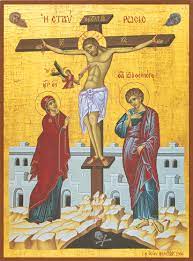 In many ways, Jesus taught by word and showed by deed that He believed Himself to be Son of God, God in the flesh. At the end of His life (at only age 33), He was executed by the Jewish authorities for blasphemy against the one God, for “making Himself equal with God”. He then rose from death, demonstrating that they were right: He is equal with God. Before His Ascension, He said to His disciples: “All authority in Heaven and on earth has been given to Me”.
In many ways, Jesus taught by word and showed by deed that He believed Himself to be Son of God, God in the flesh. At the end of His life (at only age 33), He was executed by the Jewish authorities for blasphemy against the one God, for “making Himself equal with God”. He then rose from death, demonstrating that they were right: He is equal with God. Before His Ascension, He said to His disciples: “All authority in Heaven and on earth has been given to Me”.
Put those words (and much else He said) in the words of any other human being who has ever lived and… as C.S.  Lewis put it, there are only three choices: Jesus Christ was a madman (but His clear life-giving teachings have guided and inspired much of the world ever since), or He was totally evil (but His followers believed He was without sin), or He was what He seemed: God in the flesh. The experience of millions, no billions, of Christians with Him ever since tell us this is true.
Lewis put it, there are only three choices: Jesus Christ was a madman (but His clear life-giving teachings have guided and inspired much of the world ever since), or He was totally evil (but His followers believed He was without sin), or He was what He seemed: God in the flesh. The experience of millions, no billions, of Christians with Him ever since tell us this is true.
All the above was recorded in the Holy Gospels, four books written by those who had either known Jesus personally, or else the information therein came directly from those who had known Him. Were the Gospels authentic? Almost every evidence says they were – no time to go into that now.
On the basis of all this evidence, the Fathers of the First Ecumenical Council (Nicaea 1) authorized by the first two paragraphs of the Creed, describing One God: the Father and the Son.
3 God the Holy Spirit
The Spirit of God is referred to often in the Old Testament.
 by Phiddipus, 2008 (Public Domain)
by Phiddipus, 2008 (Public Domain)
On the same night before He was crucified, Christ spoke of the coming of the Holy Spirit:“If you love me, keep my commands. And I will ask the Father, and He will give you another παράκλητος [“Paraklete”, “Advocate”, “Counsellor”, “Helper” – the word doesn’t translate precisely] to help you and be with you forever— the Spirit of truth.” Jesus promised that the Holy Spirit would lead His Church into all truth, help us in our weakness, pray within us. Christ called the Holy Spirit “He”, a Person. God never deals with us in an impersonal way.
On Pentecost, fifty days after Christ’s Resurrection, the Holy Spirit came upon the disciples with power. Ever since then, through the Anointing (“Chrismation”) at the end of Baptism, He dwells within Christian people making us temples of His Presence. He gives spiritual gifts of many sorts. Peoples’ experience with God through His Spirit through history has been personal, not impersonal.
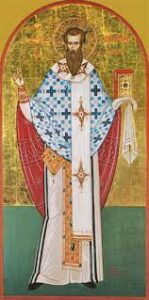 Saint Basil the Great (anonymous, late 20th c)
Saint Basil the Great (anonymous, late 20th c)
The Holy Spirit is the more “hidden” Person of the Holy Trinity, at least in this Age. It required the systematic Biblical study of Saint Basil the Great and Saint Gregory of Nazianzus (Gregory the Theologian) in the Fourth Century to demonstrate that, given the way the Holy Spirit is described and addressed and prayed to in the Holy Scriptures, there is only one conclusion: The Holy Spirit is God, the Third Person within the Holy Trinity.
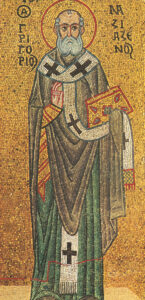
Therefore at the Second Ecumenical Council (Constantinople I) the Fathers added a third paragraph to the Creed: “And I believe in the Holy Spirit…”
Saint Gregory the Theologian (Saint Mark’s Cathedral, Venice, 13th c)
God the Holy Trinity
Almost like good scientists, the Holy Fathers of the Church took this “given evidence” and came to certain “deductions”: Reason alone shows there must be a Creator, Designer and Sustainer “behind” the cosmos, else everything would stop or fall apart! The experience of the Jews revealed that there is one God. Yet Jesus Christ revealed Himself as God, who yet taught and prayed to God as His Father – two distinct Persons of God. He also taught about the Holy Spirit as a distinct Person whom He would “send”. Just before His Ascension, Christ commanded Baptism “in the name of the Father and of the Son and of the Holy Spirit”. Deducing the first two Persons of the Trinity was fairly simple. It took more time and experience and Scriptural study to be sure the Holy Spirit also is God.
And there we are: Despite the fact that belief in One God is central to our Tradition, the One God must somehow exist in Three Persons. Do we understand this? Can we explain it? Not at all. All we can do is attempt to describe it. Given the evidence, there were no other possible conclusions. This has been the Faith of God’s Holy Church ever since. The title “Holy Trinity” was first used by Tertullian in the late Second Century.
Is there an adequate icon of the Holy Trinity? Of course not, since neither the Father nor the Spirit can be seen. Here is the classic icon of the Trinity, using the three “angels”/”men”/”the Lord” who visited Abraham and Sarah to represent them. Do you know which represent the Father? the Son? the Holy Spirit?
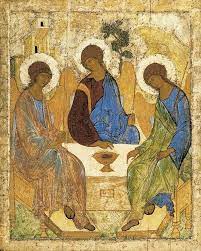
Andrei Rublev, 16th c, Russia
From the Holy Trinity, we have come to see that not only are individual persons created in the image of God, but also that all society, every good human “community”, is created in the image the Holy Trinity: Persons fully united in love. This is particularly true of the human family itself. God Himself is a “Family”!
Remember that the Church’s doctrines about God never fully describe Him. They are really only a “fence around the Mystery”, so that we will not be led astray by heresies which would try to reduce and confine God, making Him only a product of mere human reason or philosophy.
“So, now, do you have any questions about the Holy Trinity?”
I hope so! for there is much more that could be said about the Mystery – describing, but not explaining, mind you – and infinitely more that is beyond description.
This Post has already gone on much too long, and every time I proofread it, I see something else that should be said, and so therefore…The End.
_______________________________________
Speaking of heresies, if I have committed any heresies in my over-simplification above, please point them out below, and I will correct them.
Next Week: as promised, The Wedding in Cana of Galilee
Week after Next: unless something else comes up, Abortion revisited